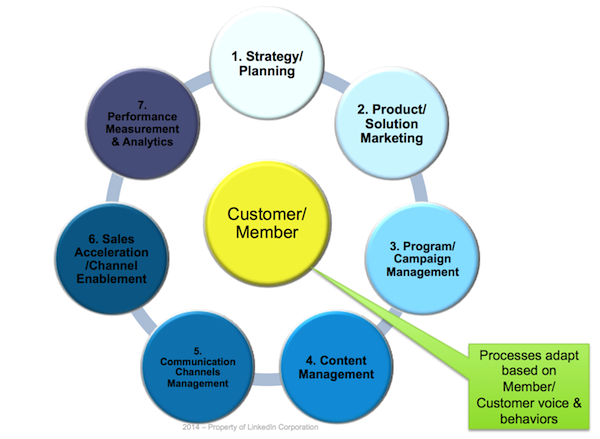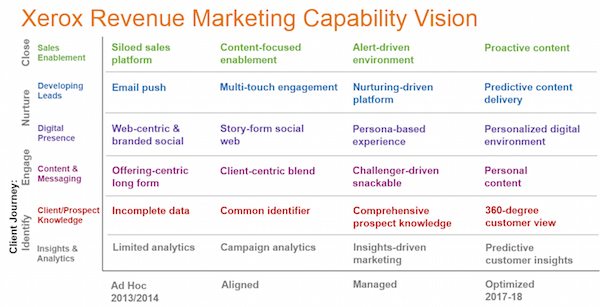It’s fascinating to watch a new profession — marketing technologists — emerge from the digital star foundry.
It’s a phenomenon that we should expect to see more frequently in The Second Machine Age. But while that’s thought-provoking at a theoretical level, it’s breathtaking to watch it actually happen with real people you know.
It also reveals how much we rely on patterns from the past to determine what we believe about the future — unfortunately, a fallacy in such a rapidly changing world.
As the chatter around marketing technologists has increased over the past few years, many people have been skeptical — largely because they had not seen these roles before. Recruiters would search LinkedIn for the title “chief marketing technologist” or similar variations, find few or none, and declare such candidates so rare as to be statistically unrecruitable.
Yet evidence of this new hybrid profession spreading has continued to mount — such as Laura McLellan’s study of these marketing tech leaders in large firms, showing that, titles aside, marketing technologist roles were proliferating rapidly. Harvard Business Review has acknowledged this new role. And the digital staffing agency Mondo recently broke ranks with their peers and named chief marketing technologists their #1 role being placed.
Perhaps the most direct evidence I’ve seen, however, has been the terrific response to the MarTech conference — which is drawing hundreds of marketing technology “unicorns” to Boston next month. (As I’m writing this, we’re down to about 30 tickets left — if you want to come to this first MarTech, better register fast!)
This led me to a revelation: marketing technologists — or people capable of being marketing technologists — are not rare. It’s just that the profession was rare, at least formally, up until very recently.
It’s an important distinction. There are actually a lot of people who would make great marketing technologists — and probably many who are already doing this role without the title. I think back to a post I wrote two years ago, about how engineers are becoming a lot like marketers. In many ways, important parts of marketing are now essentially engineering challenges — and it’s a great opportunity that is appealing to more and more technical professionals.
That’s not to say that marketing technologists grow on trees. Even good engineers are hard to find in a world that is dominated by engineering. But they’re not as rare as unicorns. And for marketing executives who are willing to embrace these professionals — even without an obvious breadcrumb of previous “marketing technologist” titles on a resume — they stand to reap tremendous value from this first official generation of this new profession.
As Exhibit A, I’m really excited to share the following Q&A with Saad Hameed, who is LinkedIn’s head of marketing technology — and a terrific example of an engineer-turned-marketing-technologist who is helping to shape the future of marketing at one of the Internet’s leading companies.
Tell us a little bit about your background and how you got to your current position.
I started my career as a software engineer at Sun Microsystems in 2000. While working at Sun, I realized that my calling was more in marketing, to understand customer needs and to help market solutions that addressed them.
The transition from engineering to marketing has been an intriguing journey. I’ve had roles traversing departmental boundaries across business development, customer operations, sales operations, demand generation, IT, and marketing operations. This enabled me to understand the customer journey and to create a vision for a customer lifecycle strategy/ops that is more holistic.
My previous role at LinkedIn was a leader of marketing operations. And then a year ago, I was offered the opportunity to lead the newly defined marketing technology function.
Can you describe a little more about your new role and the decision to take a centralized approach to marketing technology at LinkedIn? How does that interconnect with the rest of marketing?
The genesis of this role started in August 2013. LinkedIn at that time had three marketing departments: enterprise, online/e-commerce, and consumer. The VP of enterprise marketing decided that the group needed a centralized role focused on the full range of marketing technology.
The VP of enterprise marketing decided that the group needed a centralized role focused on the full range of marketing technology.
At the time I was offered this opportunity, I was leading the team managing our marketing automation and sales enablement function. The opportunity was intriguing, as it would pioneer the vision, architecture, and roadmap for the future of marketing technology at LinkedIn. I took the role as it better aligned with my interest to impact with a broader set of marketing capabilities instead of merely specific components such as marketing automation.
At the beginning of 2014, LinkedIn’s chief marketing officer restructured the marketing organization with a single team to horizontally manage marketing operations. As a result, my role has expanded to cover all areas of marketing. My current focus is to define the marketing technology vision, architecture, roadmap, technology selection, and working with marketing and both internal and external technology partners to deploy prototypes.
What are some of the successes that you’ve had with this new role?
The key accomplishments have been building a holistic vision, strategy, and roadmap for marketing technology. As a result, we have seen increased acceleration in our ability to deploy new technologies and significantly reduced costs by eliminating silos and overlaps.
We have seen increased acceleration in our ability to deploy new technologies and significantly reduced costs by eliminating silos and overlaps.
Amongst the foundational efforts that catalyzed these results included creation of a process-based framework that identified areas of technology pains and opportunities. Below is the level 0 of this marketing process framework; this was further expanded into a more detailed level 1 process framework that pinpointed core areas of marketing technology needs and priorities:
What’s been most challenging?
Given that marketing technology is in a such a rapid, evolutionary phase, one challenge is working through the still changing definition of the marketing technology role and its scope.
What’s the relationship between your marketing technology team and other IT teams within the company? What kind of governance exists around your work?
I partner with business analytics, data infrastructure, IT services, and web development teams. The relationships with these teams are evolving from technical solution implementation and management to more strategic partnerships.
As part of this transformation, I involve our partners much earlier in the lifecycle of our initiatives, especially during the strategy formulation phase. This results in higher engagement from the technical teams and improved acceleration of projects — and reduced rework. The next steps are for me and other marketers to further expand these relationships.
I involve our partners [in IT and web development] much earlier in the lifecycle of our initiatives, especially during the strategy formulation phase.
LinkedIn is often cited as an early example of growth hacking to grow usage of the service. Is growth hacking a part of the broader marketing culture? How does marketing technology influence — or is influenced by — your culture?
Growth hacking has been core part of our marketing culture and programs. In terms of marketing technology initiatives, the focus is enabling technologies and processes that accelerate monetization.
From a process standpoint, I have led an initiative, along with core group of technology partners, to implement Agile for a business intelligence initiative. From a sales enablement perspective, we have deployed a propensity model for account scoring to accelerate revenue generation. The next initiative that the team and I are doing discovery on is automating lifecycle marketing.
What is the most interesting area of innovation in marketing technology to you today?
Application of machine learning to automate lifecycle marketing is highly interesting to me. This is uncharted territory in my opinion, one that requires both science and art to come together. Another key area of interest is building a content assembly engine that leverages data insights to help automate steps in the content generation process.
Thank you, Saad — we appreciate you sharing your experience with us!





Scott, Thanks for sharing the Q&A with Saad. It is quite interesting to know that companies like linkedin are also going through similar challenges faced in the B2B companies around decentralized marketing. Especially how the role of Marketing Technologists is helping in hightech and non-hightech companies to evolve and adapt the right technologies to empower marketing in the right way.
I strongly agree with the he challenge mentioned by Saad around working through the still changing definition of the marketing technology role and its scope. In my own case this definition has changed for me within my own perspective in last 1 year. It keeps on evolving 🙂
Definitely, this article also falls inline with my own personal experience in how this role is not just about plugging technology with business but about bringing in a new culture and defining digital strategy in many cases.
Keep on sharing these articles on your site as these are really helpful in my own personal journey. Thanks a lot again.
Thanks, Rohit! Let me know if you’d be interested in participating in a similar Q&A — I’m sure other readers would love to hear of your evolutionary adventure.
Scott, looking forward to contribute to the community. I appreciate the opportunity.